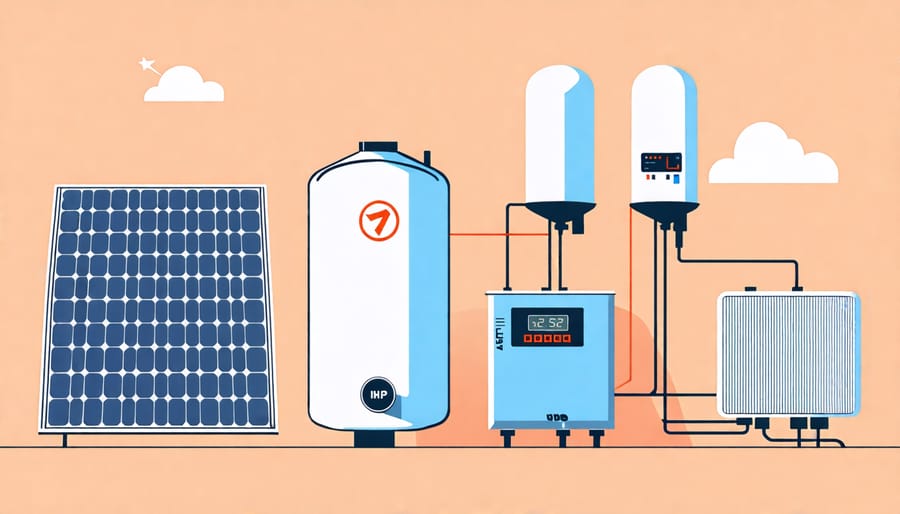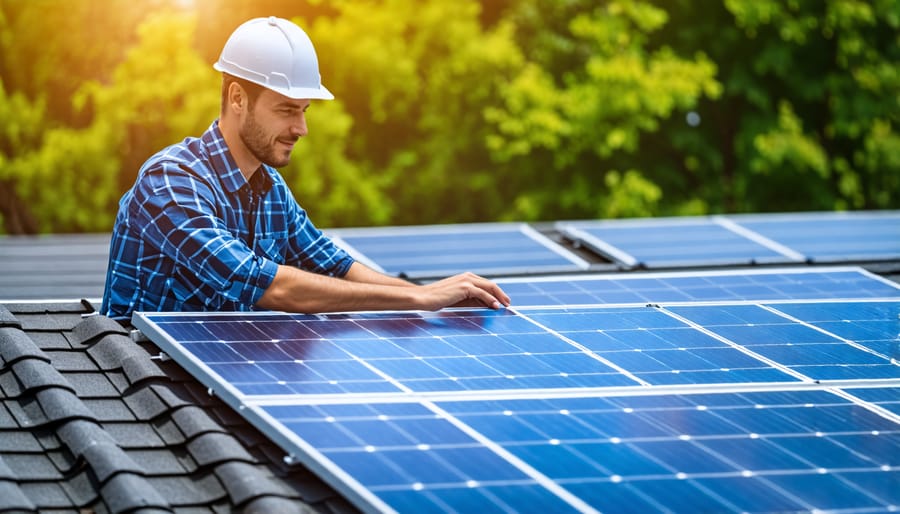Energize Your Home: How to Install a Solar Hot Water Heater with Ease

Gather all necessary tools and materials, including solar collectors, storage tank, mounting hardware, and piping. Plan the optimal positioning of the solar collectors to maximize sun exposure, ideally on a south-facing roof or wall, considering local climate and shading. Secure the mounting hardware firmly, ensuring it adheres to safety regulations and structural integrity requirements specific to your European location. Connect the solar collectors to the storage tank using insulated piping, ensuring minimal heat loss and efficient water flow, while adhering to European standards for system efficiency and sustainability.
Understanding Solar Hot Water Heaters
Components Overview
A solar hot water system comprises several key components that work in harmony to harness solar energy efficiently. The collector, mounted on rooftops across Europe, absorbs sunlight, converting it into heat. This innovative technology optimizes energy capture even in less sunny climates. The storage tank, typically insulated, retains the heated water, ensuring a sustainable supply. A well-designed system can dramatically improve energy efficiency in both homes and industries. The controller is pivotal, regulating the exchange between the collector and storage tank, maintaining optimal temperatures, and preventing overheating. These components together facilitate a sustainable and impactful solar energy solution.

Benefits of Solar Heating
Solar heating offers numerous benefits, particularly for environmentally-conscious European homeowners, businesses, and industries. By harnessing the abundant solar energy, solar hot water heaters significantly reduce energy bills, easing the financial burden associated with traditional heating methods. This sustainable technology not only lowers operational costs but also substantially decreases carbon footprints, promoting a cleaner environment. Embracing solar heating reflects a commitment to innovation and efficiency, aligning with broader European goals for sustainability. European initiatives often provide comprehensive support, from initial installation to ongoing maintenance, ensuring a seamless transition to renewable energy solutions.
Planning Your Installation
Site Assessment
Ensuring that your solar hot water heater installation is successful begins with a thorough site assessment. Start by evaluating your roof space to determine if it can accommodate solar panels. Consider both the size and orientation, ensuring the area aligns primarily with the south to maximize efficiency. Next, assess sunlight availability throughout the year. Understand any seasonal variances in sunlight and note potential obstructions like tall trees or nearby buildings that could cause shading. Finally, confirm the structural integrity of your roof. It must support the system’s weight and withstand local weather conditions. Consulting with a professional can provide detailed insights and peace of mind, ensuring your project is both innovative and sustainable.

Choosing the Right System
Selecting the right solar hot water heater involves considering several crucial factors tailored to your specific needs and budget. Start with assessing your household’s hot water demand, which largely hinges on the number of occupants and their usage patterns. For a family of four in a typical European home, a system with a capacity of around 300-400 liters is generally ideal, striking a balance between availability and cost. Next, assess the climatic conditions of your location. In regions with plentiful sunshine, a direct system with flat collectors might be sufficient. However, for areas with prolonged cold spells, an indirect system with evacuated tube collectors could provide enhanced efficiency.
Additionally, factor in your budgetary constraints while considering the long-term savings on energy bills. Be mindful of installation and maintenance support, which are essential for seamless operation and longevity of the system. Emphasizing sustainability, choose systems that offer high efficiency and minimal environmental impact. Embrace innovation and consult with local experts to ensure a comprehensive and supportive project experience, propelling your transition to a cleaner energy future.
Installation Process
Pre-Installation Preparations
Before embarking on the exciting journey of installing a solar hot water heater, thorough preparation is vital to ensure efficiency and sustainability in your European context. Begin by gathering essential tools, including wrenches, pipe cutters, and a level. Accurate project execution depends on having the right equipment at hand. Next, inspect your installation site to identify optimal placement for sun exposure, crucial for maximizing solar energy use. Evaluate existing infrastructure and check for potential roof replacement factors that may impact the installation process. Comprehensive site assessment ensures your solar hot water system is both innovative and operationally sound.

Mounting the Collector
Securing the solar collector on your roof is a pivotal step in the journey towards renewable energy efficiency. To start, confirm the type of roof you have—commonly tile, slate, or asphalt in many European homes—which will determine the specific mounting hardware needed. Choose a spot with optimal sun exposure, ideally facing south, to maximize your system’s efficiency. Before proceeding, ensure your roof is structurally sound enough to bear the weight of the solar collector. Harness the principles of solar panel installation as you position the collector; this involves using robust mounting brackets to fix it securely. It’s crucial to maintain a slight angle to aid in the free flow of water and prevent damage. Remember to leave space for thermal expansion, which ensures the system remains intact through varying weather conditions. Consulting a professional can simplify this process, providing assurance of safety and compliance with local regulations. Embrace this sustainable venture knowing you’re contributing to a greener future.
Connecting to Plumbing
To integrate your solar hot water heater into your existing plumbing setup, start by turning off the main water supply and draining your current water heater. Carefully identify the cold-water inlet and hot-water outlet pipes on your heater; these are your points of connection. Cut the cold-water inlet pipe and install a tee fitting with one branch leading to the existing heater and the other to the solar system. This allows cold water to enter the solar collector for heating. Next, cut the hot-water outlet pipe and attach it to the output of your solar storage tank, ensuring a continuous flow of hot water into your existing system. Use compatible connectors and fittings that meet European plumbing standards for efficient and safe water flow. Insulate all pipes to maximize energy efficiency, reducing heat loss during transit. This integration not only enhances your system’s performance but also contributes significantly to sustainability goals across Europe, promoting innovative practices and efficient energy use.
Electrical Connections
Connecting the electrical components of your solar hot water heater is a crucial step towards harnessing sustainable energy. Begin by securing the system’s controller, which optimizes performance by regulating the temperature and ensuring efficiency—key aspects for any European homeowner committed to sustainability. Carefully follow the manufacturer’s instructions to wire the controller correctly, paying special attention to safety standards. Ensure all connections are dry and secure, and use insulated cables to avoid any electrical hazards. By integrating these innovative solutions, you’re not only enhancing your home’s energy efficiency but also contributing to Europe’s renewable energy goals. Proper electrical installation will ensure a reliable and sustainable hot water supply for years to come.
Testing and Final Adjustments
Once your solar hot water heater is installed, it’s crucial to assess its performance to ensure optimal efficiency. Begin by slowly introducing water into the system while inspecting for any leaks, particularly at connection points. Activate the system and monitor water temperature to confirm it’s heating effectively, adjusting the thermostat if necessary. Testing should occur over a few days to account for variable sunlight conditions typical in Europe. Pay attention to the system’s responsiveness to changes in solar exposure, making fine-tuned adjustments to maximize energy capture. This step ensures your investment contributes to long-term sustainability and energy savings, showcasing innovation in solar technology.
Maintenance Tips
Regular Inspections
Regular inspections are crucial for maintaining the efficiency and longevity of your solar hot water heater. Begin by checking the collector panels for any physical damage or debris, which could affect performance. Ensure that all connections and seals are intact, preventing any potential leaks. The pump system should be free of unusual noises, indicating smooth operation. Assess the heat transfer fluid levels, topping up if necessary, to maintain optimal heat exchange. Inspect the storage tank for signs of corrosion or sediment build-up. Embrace innovative approaches to upkeep, aligning with Europe’s commitment to sustainability. For more personalized guidance, consider exploring DIY solar projects to further enhance your setup.
Professional Servicing
While installing a solar hot water heater can be a rewarding endeavor, certain maintenance tasks are best left to professionals to ensure optimal performance and safety. If you notice a significant drop in water temperature or leaks, it’s time to call an expert. Regular inspections, ideally once a year, are crucial for maintaining system efficiency and longevity, given the unique weather patterns across Europe. A professional can check for component wear, handle complex repairs, and optimize your system for peak seasonal performance. This proactive approach not only enhances energy efficiency but also supports your commitment to environmental sustainability and innovation.
Conclusion
Solar hot water systems offer a sustainable and efficient solution for European homeowners, businesses, and industries striving for energy innovation. By harnessing the sun’s power, these systems reduce energy costs and carbon footprints while promoting sustainability. Throughout the installation process, comprehensive support ensures smooth implementation, maximizing the system’s benefits. Embracing solar hot water technology aligns with Europe’s commitment to renewable energy and environmental responsibility. For ongoing efficiency, regular solar panel maintenance is essential. By investing in this green technology, you contribute to a more sustainable future, benefiting both the environment and society.
References and Resources
For European homeowners, businesses, and industries eager to harness solar energy, exploring resources by INOX Solar is a great start. Their services include technical guides and project support, emphasizing sustainable innovation. To dive deeper into understanding solar installations, INOX Solar offers an extensive array of insightful articles and tools aimed at enhancing energy efficiency. Their projects highlight the European impact, showcasing how solar energy supports regional sustainability goals. For personalized advice, reach out to their expert team, who provide tailored solutions and hands-on assistance throughout your solar journey. Discover the benefits of solar energy and how INOX Solar can support your transition to greener solutions.
Leave a Reply